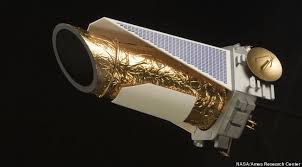The Kepler Mission: NASA’s Window to the Universe
The Kepler mission, led by NASA, has revolutionized our understanding of the cosmos and our place within it. Launched in 2009, Kepler was a space observatory designed to search for Earth-sized planets orbiting other stars. Named after the famous astronomer Johannes Kepler, this mission has provided a wealth of data that has reshaped our knowledge of exoplanets and planetary systems.
Discoveries and Achievements
Over its nine-year mission, Kepler made numerous groundbreaking discoveries. One of its most significant achievements was confirming the existence of thousands of exoplanets outside our solar system. By observing the tiny dimming of starlight as planets passed in front of their host stars, Kepler identified these distant worlds and provided valuable insights into their size, composition, and orbital characteristics.
Kepler’s discoveries include a wide range of exoplanets, from rocky terrestrial planets to gas giants many times larger than Jupiter. Some of these planets are located within their star’s habitable zone, where conditions might be suitable for liquid water to exist on their surfaces—a key factor in the search for extraterrestrial life.
Legacy and Impact
Although the Kepler spacecraft officially ended its mission in 2018 due to depleted fuel reserves, its legacy continues to shape the field of exoplanet research. The data collected by Kepler has provided a treasure trove of information for scientists studying planetary systems beyond our own.
In addition to expanding our knowledge of exoplanets, the success of the Kepler mission has paved the way for future space observatories dedicated to exploring distant worlds. NASA’s Transiting Exoplanet Survey Satellite (TESS) is one such successor to Kepler, continuing the search for exoplanets using similar observational techniques.
Kepler’s Enduring Influence
The Kepler mission represents a milestone in humanity’s quest to explore the cosmos and understand our place in the universe. By peering into distant star systems and uncovering a multitude of diverse planets, Kepler has inspired awe and wonder among scientists and enthusiasts alike.
As we reflect on the remarkable achievements of the Kepler mission, we are reminded of the boundless potential for discovery that lies beyond our own celestial neighborhood. Thanks to NASA’s dedication to exploration and innovation, we continue to push the boundaries of knowledge and reach new frontiers in our quest for cosmic understanding.
5 Key Insights About NASA’s Kepler Mission and Its Impact on Exoplanet Discovery
- 1. Kepler was a NASA space telescope launched in 2009 to search for exoplanets.
- 2. It discovered thousands of confirmed and candidate planets beyond our solar system.
- 3. Kepler used the transit method to detect planets by observing the dimming of a star as a planet passes in front of it.
- 4. The mission ended in 2018 after fuel depletion, but its data continues to be analyzed for new discoveries.
- 5. Kepler’s findings have greatly expanded our understanding of planetary systems and the prevalence of exoplanets.
1. Kepler was a NASA space telescope launched in 2009 to search for exoplanets.
Kepler, the NASA space telescope launched in 2009, embarked on a groundbreaking mission to search for exoplanets beyond our solar system. By observing the subtle dimming of starlight as planets passed in front of their host stars, Kepler revolutionized our understanding of distant worlds and their orbital characteristics. This pioneering spacecraft played a pivotal role in identifying thousands of exoplanets, ranging from rocky terrestrial planets to massive gas giants, opening new avenues for exploration and expanding our knowledge of the universe’s vast diversity.
2. It discovered thousands of confirmed and candidate planets beyond our solar system.
The Kepler mission, spearheaded by NASA, achieved a significant milestone by uncovering thousands of confirmed and candidate planets orbiting stars outside our solar system. Through its meticulous observations of starlight dimming as planets transited in front of their host stars, Kepler provided crucial data on the existence and characteristics of these distant worlds. This groundbreaking discovery not only expanded our understanding of exoplanets but also fueled the excitement and curiosity surrounding the possibility of habitable environments beyond Earth.
3. Kepler used the transit method to detect planets by observing the dimming of a star as a planet passes in front of it.
Kepler, the renowned NASA mission, employed the transit method as a key technique to detect exoplanets. By meticulously observing the subtle dimming of a star’s brightness as a planet crosses in front of it, Kepler astronomers were able to identify and characterize distant worlds with remarkable precision. This innovative approach allowed scientists to infer crucial information about the size, orbit, and composition of these planets, leading to groundbreaking discoveries that have significantly advanced our understanding of planetary systems beyond our solar system.
4. The mission ended in 2018 after fuel depletion, but its data continues to be analyzed for new discoveries.
The Kepler mission concluded in 2018 following the depletion of its fuel reserves, marking the end of its nine-year-long exploration of exoplanets. Despite the spacecraft’s retirement, the wealth of data it collected remains a valuable resource for ongoing research and analysis. Scientists continue to delve into Kepler’s observations, uncovering new insights and making fresh discoveries about distant planetary systems. The legacy of Kepler lives on through the continued examination of its data, ensuring that its contributions to our understanding of exoplanets endure long after the mission’s conclusion.
5. Kepler’s findings have greatly expanded our understanding of planetary systems and the prevalence of exoplanets.
Kepler’s findings have significantly broadened our comprehension of planetary systems and the abundance of exoplanets in the universe. By detecting and confirming the existence of numerous exoplanets through its observations, Kepler has provided invaluable insights into the diversity and distribution of planets beyond our solar system. These discoveries have not only deepened our understanding of planetary formation and evolution but have also sparked new avenues of research into the potential habitability of distant worlds.

